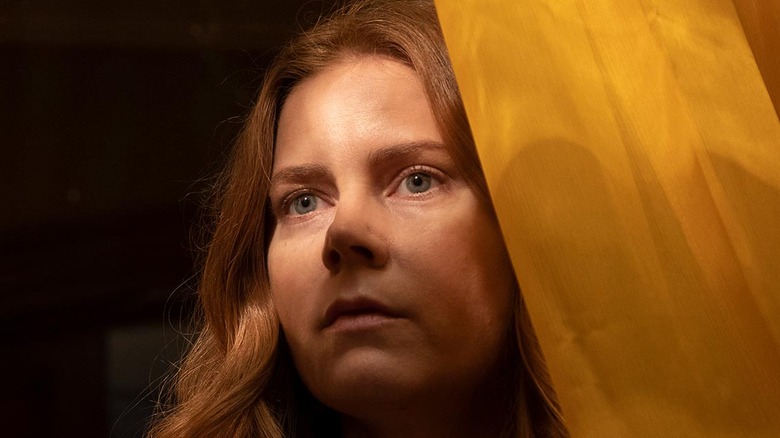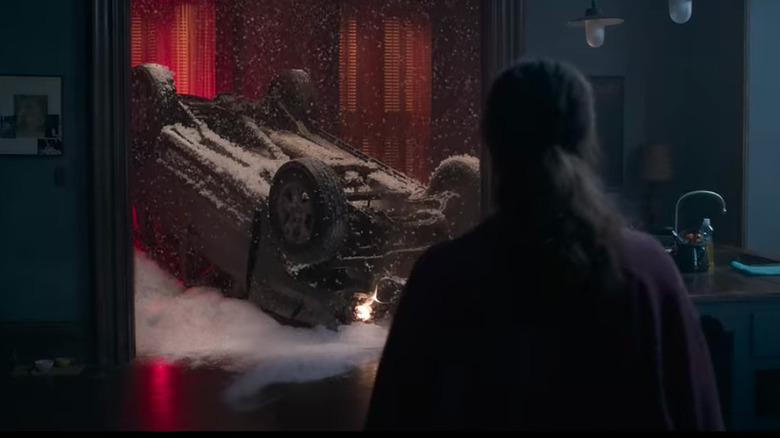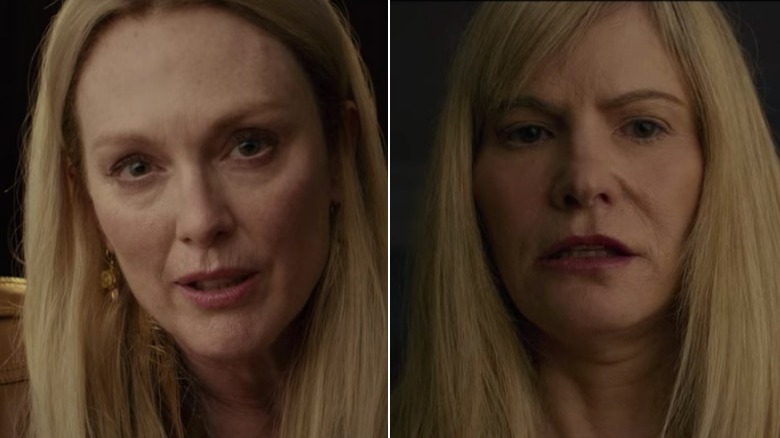The Ending Of The Woman In The Window Explained
Netflix's newest thriller "The Woman in the Window" — based on A.J. Finn's 2018 novel of the same name — explores the nature of reality and the difference between living and surviving through its protagonist Anna Fox (Amy Adams). Anna suffers from agoraphobia and hasn't left her house in almost a year. She shares her home with her cat and a basement tenant named David (Wyatt Russell) and fills her time by practicing French, calling her estranged husband and daughter, watching old movies, mixing copious amounts of alcohol with her meds, and spying on her neighbors. Though she is observing the lives of those around her, she isn't truly a part of her own.
One day, her routine is interrupted by a visit from her new neighbor's son Ethan Russell (Fred Hechinger), followed by a second stopover a few days later by his mother Jane (Julianne Moore). As Anna continues to observe the Russell home from her house, she becomes increasingly concerned about the aggressive behavior of the family patriarch Alistair (Gary Oldman) and witnesses Jane stabbed in her home during an argument a few days later.
Though she calls the police for help and even tries to intervene, she is unable to overcome her anxiety disorder and faints in the street. Even when doing her best to save her friend's life, her debilitating condition has cut her off from participating in the world. After she awakens, investigators introduce her to a completely different woman (Jennifer Jason Leigh) claiming to be Jane Russell, and the family rebuffs any claims of violence at their home.
As Anna begins to doubt her own sanity, revelations about her family's death compound her insecurities
Much like the film noir crime dramas she watches, Anna finds herself at the center of a mystery. Even when she does come across potential clues to Jane's possible existence, they further heighten her manic emotional state rather than bringing her any semblance of calm. This not only hints at her doubt in her own judgement but her personal uncertainty in the truth of her experiences.
In fact, Anna's window-murder scenario is very close to the plot of 1954's "Rear Window," the sort of film that she would definitely have watched. So it's not inconceivable that she created an imaginary crime in her mind in order to avoid her own issues. Her displays of drug and alcohol abuse make her an unreliable narrator as it is, so we can't ever be sure what we're seeing is the objective truth. The audience must experience the same confusion and shock about what actually happened that Anna must endure. Are her experiences factual or simply a fantasy she has created to occupy her time?
As her paranoia grows, she unleashes an emotional tirade culminating in the revelation that her husband and daughter have actually been dead for months from a car wreck she caused. The regular phone conversations she has with them are simply hallucinations. This realization causes her to lose all credibility, not just with others but in her own mind. It's one thing for another person to question your sanity, but the moment you begin to question your own stability and reality is no longer a reliable source, everything falls apart, like a car crash in the middle of your living room.
Will the real Jane Russell please stand up?
While completely dejected and planning to kill herself, Anna takes one last look at family pictures and sees a reflection of the woman she knew as Jane in one of the wine glasses. When she shows it to David, he reveals that he had a one-night stand with the woman, and her name is Katie. He further divulges that she is Ethan's biological mother, who abandoned him and then began stalking the Russell family.
Now, finally vindicated, Anna begs David to tell the authorities, but before the conversation goes further, he is stabbed by Ethan. Finally shedding his facade of a sensitive, timid teenager, in this moment, he reveals his true psychotic nature as a murderer. This is in stark contrast to Anna, whose mental illness manifests in very obvious physical limits, yet Ethan's mental state was not only easily disguised but functioned as a lure with its false vulnerability. It is in this moment that we realize Alistair's pleas to Anna to stay away from Ethan were not threats but, in fact, warnings for her own safety.
The two clash in a final struggle as the previously suicidal Anna is able to conjure hope again, knowing she still has some grasp on her sanity. This motivation, coupled with her instinct to survive, finally allows her to overcome her anxiety and enter her outdoor roof garden, eventually killing Ethan. His death is not only a testament to how far Anna is willing to go in order to live but also signifies that the thread between delusion and actuality she thought had snapped is still connected and she might still find her way back.
If you or anyone you know is having suicidal thoughts, please call the National Suicide Prevention Lifeline at 1-800-273-TALK (8255).


